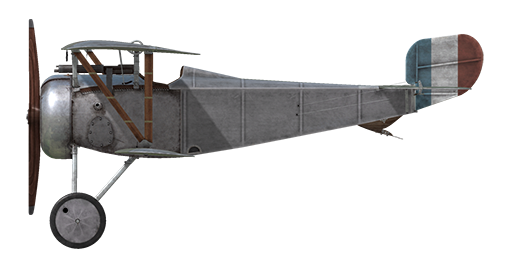il2
Nieuport 17.C1

Description
The Nieuport 17 was intended to be a further development of the Nieuport 11 fighter. When the Nieuport 17 arrived on the battlefield in March 1916, it swiftly replaced the Nieuport 11. By the end of 1916, every squadron in the French Aviation Militaire had Nieuport 17s. Compared to its predecessor, it had a larger wingspan and surface area, a more powerful engine, a Vickers machine gun, and metal aileron control wires. The plane was initially built in several French factories, but licenses were soon purchased by other countries: Great Britain, Russia, Italy, Finland and Japan.
Pilots noted its good climb rate and visibility, as well as its excellent maneuverability. The plane’s powerful engine and high dive speed exposed the main drawback of the “one and a half wing” design - a weak lower wing due to only one spar. There are two known occasions when pilots made successful landings after losing their lower wings. The introduction of the Vickers machine gun was met with ambiguity: some pilots removed and replaced it with a Lewis machine gun mounted on the upper wing. Others, however, used both machine guns simultaneously, although this somewhat decreased manoeuvrability.
Engine
9 cyl. rotary Le Rhone 9J 110 hp
Dimensions
Height: 2400 mm
Length: 5800 mm
Wing span: 8160 mm
Wing surface: 14.75 sq.m
Weight
Empty weight: 375 kg
Takeoff weight: 560 kg
Fuel capacity: 78 l
Oil capacity: 20 l
Climb rate
1000 m: 3 min. 06 sec.
2000 m: 6 min. 43 sec.
3000 m: 11 min. 34 sec.
4000 m: 19 min. 23 sec.
5000 m: 33 min. 08 sec.
Maximum airspeed (IAS)
sea level — 165 km/h
1000 m — 155 km/h
2000 m — 145 km/h
3000 m — 132 km/h
4000 m — 117 km/h
5000 m — 95 km/h
Service ceiling 5350 m
Endurance at 1000 m
nominal power (combat) — 1 h. 50 min.
minimal consumption (cruise) — 2 h. 40 min.
Armament
Forward firing: 1 х Vickers Mk.I 7,69mm, 400 rounds per barrel.
References
1) Nieuport Fighters in action. Aircraft Number 167.
2) Nieuport Fighters. JM Bruce Windsock Datafile, vol.1 and vol.2.
3) Profile Publications. The Nieuport 17 Number 49.
Modifications
Compass
L.Maxant Compass
Additional mass: 1 kg
Twin Lewis Overwing
Two overwing mounted additional fixed Lewis machineguns.
Ammo: 582 of 7.69mm rounds (6 drums with 97 rounds in each)
Projectile weight: 11 g
Muzzle velocity: 745 m/s
Rate of fire: 550 rpm
Guns weight: 16 kg (w/o ammo drums)
Mounts weight: 6 kg
Ammo weight: 24 kg
Total weight: 46 kg
Estimated speed loss: 7-18 km/h
Aldis
Aldis Refractor-type Collimator Sight (imported from Britain)
Additional mass: 2 kg
Cockpit light
Cockpit illumination lamp for night sorties
Additional mass: 1 kg
Le-Chretien
Le-Chretien Refractor-type Collimator Sight
Additional mass: 1 kg
LePrieur rockets
8 x strut-mounted “Le Prieur” anti-balloon rockets of incendary action, with pointed triangular blade attached to nose cone to asssit penetration of balloon envelope or with high explosive grenade.
Additional mass: 36 kg
Ammunition mass: 16 kg
Racks mass: 20 kg
Estimated speed loss before launch: 8 km/h
Estimated speed loss after launch: 6 km/h
Anemometer, Altimeter, Clock
E.Badin Anemometer (70..200 km/h at 2000 m and 80..220 km/h at 4000 m)
Additional mass: 1 kg
Peltret and Lafage Altimeter (0..5000m)
Additional mass: 1 kg
Mechanical Clock
Additional mass: 1 kg
Lewis Overwing
Cockpit mounted additional Lewis machinegun with changeable position.
Ammo: 291 of 7.69mm rounds (3 drums with 97 rounds in each)
Forward position: 25°
Upward position: 45°
Projectile weight: 11 g
Muzzle velocity: 745 m/s
Rate of fire: 550 rpm
Guns weight: 7.5 kg (w/o ammo drum)
Mounts weight: 0.8 kg
Ammo weight: 12 kg
Total weight: 20.3 kg
Estimated speed loss: 5 km/h